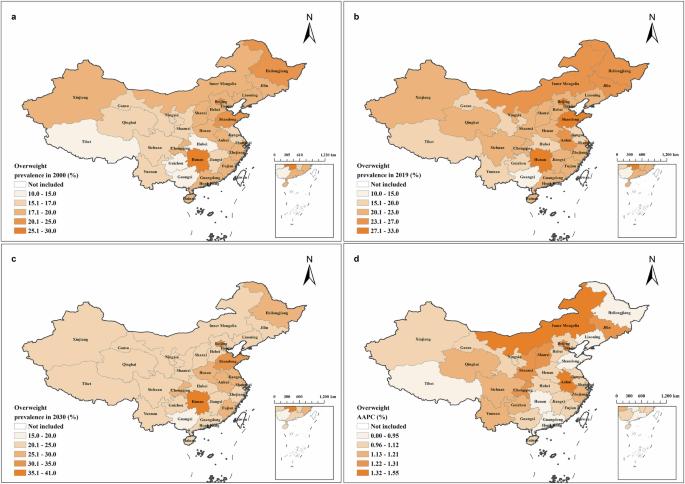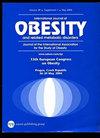Prevalence and changes of childhood overweight across China and its provinces from 2000 to 2030
IF 3.8
2区 医学
Q1 ENDOCRINOLOGY & METABOLISM
引用次数: 0
Abstract
Childhood obesity has emerged as a significant public health challenge and there is an urgent need to improve the effectiveness of local government governance to curb its growth. We aimed to estimate the prevalence and changes of childhood overweight (including obesity) across China and its provinces from 2000 to 2019 and to project the prevalence by 2030, stratified by sex. This study utilized data from the Institute for Health Metrics and Evaluation (IHME), which generated local-, administrative-, and national-level estimates of overweight prevalence among children under 5 years of age at a 5 × 5 km resolution for several low- and middle-income countries (LMICs) between 2000 and 2019 using a model-based geostatistical approach. Temporal trends were analyzed by sex and region using Joinpoint Regression, while overweight prevalence in China and its provinces was projected up to 2030 using polynomial regression models. Overweight prevalence among children under five years of age increased from 17.9% (95% CI: 14.9 to 21.3) in 2000 to 22.1% (95% CI: 14.9 to 30.9) in 2019, which was higher among boys than girls. Extrapolating from current growth trends, the forecast results showed approximately 25.1% (95% CI: 23.2 to 27.0) of children in China would be overweight by 2030. Only two of the 31 provinces (Shanxi and Inner Mongolia) were on track to meet China’s obesity prevention and control targets by 2030. The overweight burden from 2000 to 2019 was assessed across 33 provincial-level administrative units, with the greatest burdens concentrated in northeastern China and the provinces of Hunan, Hong Kong, and Macao. Childhood obesity in China has become a major public health problem with a steadily rising prevalence. This study underscores the urgent need for evidence-based policy and clinical interventions to stem the tide of obesity in Chinese preschool children.

2000 - 2030年中国各省市儿童超重患病率及变化
目标:儿童肥胖已成为一项重大的公共卫生挑战,迫切需要提高地方政府治理的效率,以遏制其增长。我们的目的是估计2000年至2019年中国及其各省儿童超重(包括肥胖)的患病率和变化,并按性别分层预测到2030年的患病率。方法:本研究利用了卫生计量与评估研究所(IHME)的数据,该数据使用基于模型的地理统计学方法,在2000年至2019年期间,以5 × 5公里分辨率对几个低收入和中等收入国家(LMICs) 5岁以下儿童超重患病率进行了地方、行政和国家层面的估计。使用Joinpoint回归分析了性别和地区的时间趋势,并使用多项式回归模型预测了中国及其各省到2030年的超重患病率。结果:5岁以下儿童的超重患病率从2000年的17.9% (95% CI: 14.9至21.3)增加到2019年的22.1% (95% CI: 14.9至30.9),其中男孩高于女孩。从目前的增长趋势推断,预测结果显示,到2030年,中国约有25.1% (95% CI: 23.2至27.0)的儿童将超重。在31个省份中,只有两个省份(山西和内蒙古)有望在2030年前实现中国的肥胖预防和控制目标。2000年至2019年的超重负担在33个省级行政单位进行了评估,其中最重的负担集中在中国东北以及湖南、香港和澳门等省。结论:儿童肥胖在中国已成为一个主要的公共卫生问题,患病率稳步上升。这项研究强调了迫切需要循证政策和临床干预来遏制中国学龄前儿童肥胖的趋势。
本文章由计算机程序翻译,如有差异,请以英文原文为准。
求助全文
约1分钟内获得全文
求助全文
来源期刊

International Journal of Obesity
医学-内分泌学与代谢
CiteScore
10.00
自引率
2.00%
发文量
221
审稿时长
3 months
期刊介绍:
The International Journal of Obesity is a multi-disciplinary forum for research describing basic, clinical and applied studies in biochemistry, physiology, genetics and nutrition, molecular, metabolic, psychological and epidemiological aspects of obesity and related disorders.
We publish a range of content types including original research articles, technical reports, reviews, correspondence and brief communications that elaborate on significant advances in the field and cover topical issues.
 求助内容:
求助内容: 应助结果提醒方式:
应助结果提醒方式:


